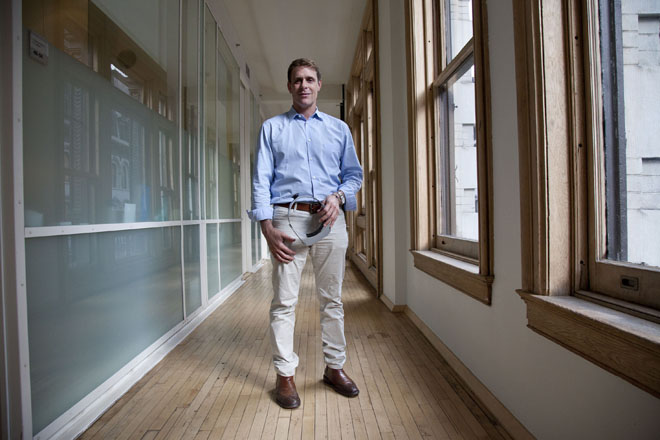
Myra Iqbal
When I stopped by the office of dermatologist David Colbert for his signature Triad treatment, I expected to discuss my clogged pores, not the 1980s East Village art scene. But after receiving the popular facial --consisting of microdermabrasion, laser toning and chemical peeling -- talk turned to his Keith Haring acquisitions, and the time he found a refrigerator door fragment signed by onetime neighbor Jean-Michel Basquiat in the garbage outside his former Bleecker Street residence. He then gamely brought out his iPad to show me photos of his collection, which includes works by the likes of Henri Matisse and Georges Braque. Colbert’s laid-back demeanor and enthusiasm for the creative seem to befit an artist more than a doctor, which might explain why he’s gained the trust of an elite group of Hollywood insiders, such as Rachel Weisz and Naomi Watts.
Colbert has a film resume to rival many industry heavyweights, having lent his aesthetic expertise to “Salt,” “A Beautiful Mind” and “The Constant Gardener.” And though tending to actors’ cold sores, blemishes and other last-minute facial crises sometimes involves early-morning set visits, Dr. Colbert makes the time in his increasingly packed schedule --which includes running his private practice, working on a yet-unnamed children’s book and spearheading various philanthropic projects.
“I live outside the box in every way,” says the soft-spoken, free-spirited physician, from his serene, sun-filled office in Manhattan’s Flatiron district. “I surf, I travel, I collect art. I don’t believe in following someone else’s formula for success.”
His observation that his clients with the healthiest complexions -- Weisz and Watts -- were farmers’ market enthusiasts sparked his first book. “Rachel has luminous, diaphanous skin with almost no pores,” he reveals. “Naomi has vibrant, resilient, elastin-filled skin with an amazing glow.”
The tome’s title, The High School Reunion Diet, was inspired by patients seeking beautifying help before facing former frenemies. “It’s either a wedding, a bar mitzvah, a confirmation, or some sort of event that marks time … but especially the high school reunion. Every American can relate to that. It’s Molly Ringwald!,” he says, referring to the ‘80s poster girl for teen angst. The book is blurbed by John Hughes’ muse herself, who notes, “Dr. Colbert is like your favorite high school teacher -- very funny, a little sarcastic and a lot subversive.”
And some of his clients requesting pre-reunion regimens are far older than the Brat Pack. “One was for a high school reunion that I’d never heard of before--I was surprised there were so many people alive from the class,” Colbert says. “Those are the survivors of the Titanic. And the person just looked so great.”
For the record, Colbert has not had to undergo any last-minute treatments before attending his own reunions (“I live in the world of preparation. I’m a doctor.”) He does, however, keep an hourglass at home as a reminder that “everything’s limited.” “The older you get, the more you see it,” he says. “I think it’s okay to be philosophical about aging.” Colbert’s own regimen varies as necessary: “I believe in listening to what your skin tells you. If you wake up and feel oily, wash your face.” The constants in his routine are daily sunblock, weekly exfoliation, argan oil for dryness, and of course, shaving, which he considers a form of microdermabrasion. “It keeps your skin really smooth.”
As an undergrad at the University of Iowa, Colbert studied zoology and French and dreamed of becoming a veterinarian. He picked up a minor in dance, which led to a stint studying with the Joffrey Ballet in New York, but ultimately decided on med school, where “for me, it was all about the skin from day one.” While studying for his board exams post-graduation he worked at a Chanel laboratory in Paris--a fitting backdrop for his subject. “I think the French created dermatology,” he says. “If you go back and look at the textbooks, while Americans were worried about the appendix, the French were looking at the skin.”
Colbert says the biggest misconception about dermatology is that sun damage is irreversible. “People have no idea that it’s like quitting smoking. You can quit burning your skin. You can quit abusing the sun.”
He adds that overzealous skincare routines are another common error. “Often people think they need to do something crazy with their skin every day. I don’t need to wash my cashmere sweaters every day in Woolite and hang them up to dry. I only need to do that once in a while.” To help patients cleanse and tone more moderately, he introduced his signature Daily Nutrition for Skin line.
Colbert’s success has allowed him to start a charity, NYDG Foundation, named for his practice, the New York Dermatology Group. The non-profit organized its first event in 2010, a benefit for those who lost their
arms and legs in Haiti’s devastating earthquake. He’s also been working with up2us.org, an organization that uses sports to foster confidence in inner-city youth.
And fortunately, some of his well-connected friends have been willing to help his causes: Watts and Weisz co-hosted his Rx Haiti fundraiser. Colbert has been working with both actresses on upcoming films: Weisz in “Oz: The Great and Powerful,” and Weisz and Watts in “Dreamhouse.”
Colbert likens his role as a skin consultant to that of a costume designer. “Your skin is what you wear. It’s a window into your soul, into your diet. And if your skin doesn’t look good, you’re not going to look good. You can’t hide it: It’s your palette.”